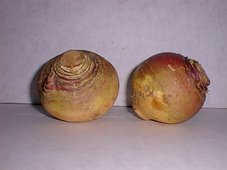 As noted in The Rutabagan just two days ago, a draft UN treaty has been completed to facilitate contingency planning for potential asteroid collisions with the earth. Today, ABC News reports that a likely candidate, asteroid Apophis, will pass very close to the earth in 2029 and again, even more closely, in 2036. Here are some excerpts from ABC's story :
As noted in The Rutabagan just two days ago, a draft UN treaty has been completed to facilitate contingency planning for potential asteroid collisions with the earth. Today, ABC News reports that a likely candidate, asteroid Apophis, will pass very close to the earth in 2029 and again, even more closely, in 2036. Here are some excerpts from ABC's story : "Circle your calendar. April 13th, 2036 could be a really, really bad day on planet Earth...
"Dr. Dan Barry, a retired astronaut, told ABC News, 'Even if the probability is low of an asteroid hitting Earth, if it has the potential to have a significant impact, then it has to be looked at. It is the absolutely responsible thing to do. In fact, it would be irresponsible not to do so.'"Barry said more research is needed so that when a potentially dangerous asteroid is found, there is a plan in place. He said it is therefore important to start the search for asteroids now, to allow enough time to effectively deal with them.
"Scientists believe that if advance warnings of dangerous asteroids like Apophis can be made decades in advance, there will be enough time to try and knock them off course.
"Nobody knows for sure what it would take to push a massive asteroid off its course, but the theoretical possibilities include detonating weapons on an asteroid's surface or using gravitational pull to alter a possible collision course. But it could also break an asteroid into many pieces, all still headed toward Earth.
"Some scientists say a better option could be to launch a large satellite to rendezvous with an asteroid. The mass of the satellite alone could produce enough gravitational pull to change the asteroid's course. [ARSI's emphasis.] Another suggestion is to crash a spacecraft into an asteroid in the hopes of changing its direction."'Done far enough away, only a small deflection would be needed and it is kept in one piece,' said Barry...
"So, while astronauts blowing up an asteroid may be movie fiction for now, scientists are already thinking about how to save Earth from a massive asteroid possibly on its way."
Scientists estimate that there are 200,000 to 400,000 large "celestial objects" that could "come within range of our home planet."
As reported here on Saturday, ARSI physicists are already creating a plan to launch a giant rutabaga whose gravity could deflect an asteroid's course. Alternatively, the rutabaga could be used as a missile to obliterate the asteroid.
Another intriguing alternative involves assembling a "cluster" of 100,000 ordinary rutabagas, with a total mass of 150 tons (140,000 kg), in lunar orbit. The rutabagas would be tightly held together by a giant fishing net, then launched toward asteroid Apophis. This interplanetary "barge" could be towed into close proximity of the asteroid, where it would be able to exert enough gravitational tug to deflect its course.
Numerous questions still have to be resolved. For example, physicists are now trying to determine whether such a large mass of rutabagas in lunar orbit would pose any risk of deforming the moon's course around the earth.
Maybe it's time for a Department of Home Planet Security.
PHOTO: NASA





1 comment:
Planet Security
Post a Comment